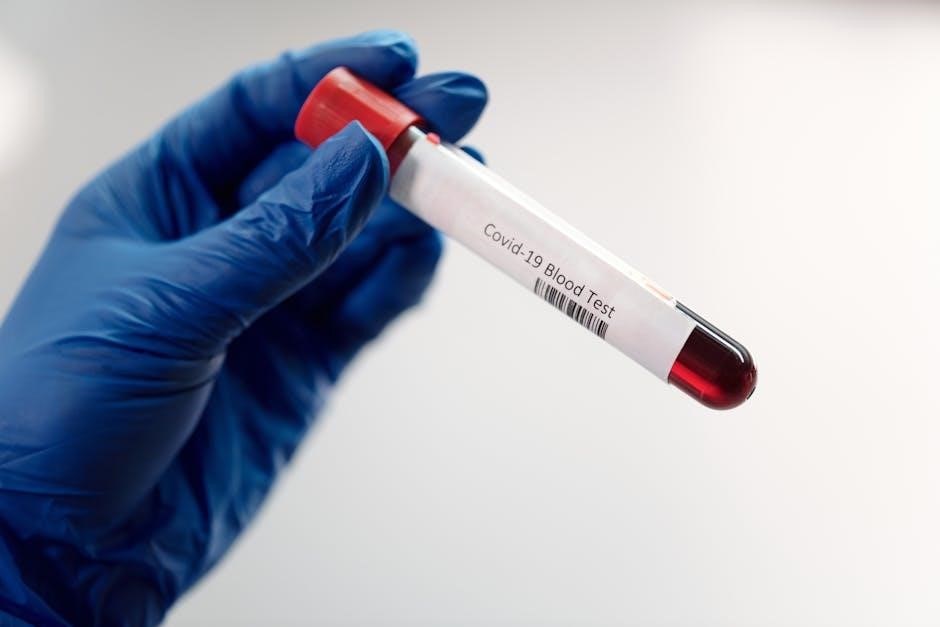
A Test Plan Sample PDF serves as a comprehensive guide for structuring and executing software testing processes․ It outlines key elements like objectives, scope, and strategies, ensuring standardized approaches․ The document often includes templates, such as IEEE 829, to streamline testing activities, making it easier to organize and track progress effectively․
What is a Test Plan?
A Test Plan is a detailed document that outlines the approach, scope, and methodology for testing a software application or system․ It serves as a blueprint, ensuring all aspects of testing are systematically planned and executed․ The document typically includes objectives, test strategies, environments, schedules, and deliverables, providing clarity on what needs to be tested, how, and when․ It acts as a guide for testers, developers, and stakeholders, ensuring alignment and consistency․ A well-structured test plan minimizes risks, improves efficiency, and ensures high-quality outcomes․ It is a dynamic document that may evolve as the project progresses, adapting to changes in requirements or scope․
Importance of a Test Plan in Software Testing
A Test Plan is essential for ensuring systematic and thorough software testing․ It helps identify potential risks early, reducing the likelihood of defects and improving overall product quality․ By outlining clear objectives, scope, and strategies, it aligns all team members and stakeholders, minimizing misunderstandings․ The document also enhances efficiency by organizing test cases and tracking progress effectively․ Additionally, it provides a framework for repeatability, allowing tests to be executed consistently across different environments and iterations․ A well-crafted test plan ensures that testing activities are focused, measurable, and aligned with project goals, ultimately contributing to the delivery of high-quality software solutions․
Overview of Test Plan Sample PDF
A Test Plan Sample PDF provides a structured blueprint for organizing and executing software testing activities․ It includes essential sections such as objectives, scope, test environments, deliverables, and responsibilities․ The document serves as a reference guide, ensuring clarity and consistency in testing processes․ By outlining the entire testing lifecycle, it helps teams stay aligned and focused on project goals․ The PDF format makes it easily shareable and accessible, while its pre-defined templates, like IEEE 829, simplify customization for specific projects․ This resource is invaluable for both novice testers and experienced professionals, offering a clear roadmap to achieve thorough and efficient testing outcomes․

Key Elements of a Test Plan
A test plan includes objectives, scope, test strategies, environments, schedules, deliverables, responsibilities, and defect tracking mechanisms, ensuring comprehensive coverage and alignment with project goals․
Objectives and Scope of Testing
The objectives of testing define the goals to be achieved, such as ensuring the product meets requirements, identifying defects, and confirming readiness for delivery․ The scope outlines the specific components, features, or functionalities to be tested, including timelines and resources․ Clearly defining these elements helps avoid ambiguity and ensures alignment with project goals․ The scope may include functional testing, performance evaluation, or user interface validation, while excluding non-critical aspects․ Well-documented objectives and scope guide the testing process, ensuring focus on high-priority areas and enabling effective resource allocation․ This section is crucial for setting expectations and maintaining clarity throughout the testing lifecycle․ Properly defined, it helps teams stay on track and deliver measurable outcomes․
Test Strategy and Approach
The test strategy outlines the overall approach to testing, defining how activities will be planned, executed, and monitored․ It includes the test levels (e․g․, unit, integration, system) and types (e․g․, functional, performance, security)․ The approach determines whether testing will follow Agile, Waterfall, or hybrid methodologies․ Tools like Selenium or JMeter may be specified for automation, while manual testing focuses on exploratory or scenario-based methods․ The strategy also covers risk mitigation, resource allocation, and communication plans․ By aligning with project goals, the test strategy ensures efficient and effective testing․ This section serves as a roadmap, guiding the team to deliver high-quality results while addressing potential challenges and constraints․ A well-defined strategy is essential for achieving testing objectives and ensuring stakeholder confidence․
Test Environment and Infrastructure

The test environment section details the hardware, software, and network configurations required for testing․ This includes specifications like operating systems, browsers, and devices․ The infrastructure encompasses tools and technologies, such as test automation frameworks (e․g․, Selenium) and performance testing tools (e;g․, JMeter)․ It also outlines the physical or virtual labs where testing occurs․ The environment must replicate real-world conditions to ensure accurate results․ Proper setup ensures compatibility and consistency, minimizing disruptions․ The infrastructure supports both manual and automated testing, enabling efficient execution․ A well-defined test environment is critical for achieving reliable and repeatable test outcomes, ensuring the system performs as expected under various scenarios․ This section is vital for aligning testing with project requirements and stakeholder expectations․
Test Schedule and Milestones
The test schedule outlines the timeline for testing activities, including start and end dates for each phase․ It details key milestones, such as test case preparation, execution, and defect resolution․ This section ensures that all testing tasks are aligned with the project timeline and resources are allocated effectively․ By breaking down the testing process into manageable phases, the schedule helps track progress and identify potential delays․ Milestones act as checkpoints to measure completion and readiness for the next phase․ Adhering to the schedule ensures that testing is completed on time, meeting project deadlines and delivering a high-quality product․ This section is crucial for maintaining clarity and accountability throughout the testing lifecycle․

Test Plan Template Structure

of a test plan provides an overview of the project, outlining its objectives, scope, and deliverables․ This section sets the stage for the entire document, offering background information on the software or system under test․ It defines the purpose and goals of the testing process, ensuring all stakeholders understand the project’s context․ The introduction also highlights the key deliverables and the expected outcomes of the testing activities․ By clearly stating the project’s vision and objectives, this section aligns the testing efforts with the overall business goals․ It serves as a foundation for the detailed sections that follow, ensuring a common understanding among team members and stakeholders․ This section is often customizable to fit specific project requirements, making it adaptable for various testing scenarios․
Test Objectives and Scope
The Test Objectives and Scope section clearly defines the goals and boundaries of the testing process․ It outlines what needs to be tested, ensuring alignment with project requirements․ This section specifies measurable objectives, such as identifying critical bugs or ensuring compliance with specific standards․ The scope details the areas or features to be tested, avoiding ambiguity․ By defining both in-scope and out-of-scope items, it helps the testing team stay focused․ This section also highlights the criteria for determining when testing is complete․ Well-defined objectives and scope ensure efficient and targeted testing, preventing unnecessary efforts and ensuring critical aspects are thoroughly evaluated․ Regular updates to the scope may occur based on project changes or new requirements;
Test Deliverables and Responsibilities
The Test Deliverables and Responsibilities section outlines the specific outputs and accountability for each team member․ Deliverables include test cases, reports, and documentation, ensuring traceability and clarity․ Responsibilities are assigned to the test team, project managers, and stakeholders, defining roles such as test case execution, defect logging, and progress monitoring․ This section ensures everyone understands their tasks, promoting collaboration and accountability․ It also specifies timelines and approval processes for deliverables, ensuring alignment with project goals․ By clearly defining roles and outputs, this section helps manage expectations and ensures successful test execution․ Regular updates and reviews of deliverables are crucial to maintain accuracy and relevance throughout the testing lifecycle․ This structured approach guarantees that all responsibilities are tracked and fulfilled effectively․
Test Methodology and Techniques

The Test Methodology and Techniques section details the approaches and tools used to execute testing․ It includes frameworks like black box, white box, and gray box testing, ensuring a systematic approach․ Risk-based testing is often employed to focus on high-risk areas, optimizing resource use․ Exploratory testing complements scripted methods, allowing testers to uncover issues intuitively․ Automation tools, such as Selenium, enhance efficiency by executing repetitive tests․ Performance and load testing ensure the software can handle expected user loads․ By combining these methodologies and techniques, the test plan ensures comprehensive coverage, meeting project requirements and delivering a high-quality product․ This section is crucial for aligning testing activities with overall project goals․

Best Practices for Creating a Test Plan
Best practices include defining clear objectives, identifying test scenarios, setting entry and exit criteria, and documenting results․ Collaboration ensures alignment with project goals and deliverables effectively․

Defining Clear Test Objectives
Defining clear test objectives is crucial for ensuring the testing process aligns with project goals․ Objectives should be specific, measurable, achievable, relevant, and time-bound (SMART)․ They outline what needs to be tested, the desired outcomes, and the criteria for success․ Clear objectives help guide test case development, ensuring coverage of critical functionalities․ They also facilitate communication among stakeholders, reducing ambiguity and misalignment․ By establishing well-defined objectives, test teams can focus on priorities, optimize resource allocation, and deliver results that meet expectations․ This step ensures that testing efforts are purposeful and contribute directly to the overall quality of the software or system being developed․
Identifying Test Scenarios and Cases
Identifying test scenarios and cases is a critical step in creating a robust test plan․ Test scenarios outline real-world situations that the software may encounter, while test cases provide detailed, step-by-step instructions for verifying specific functionalities․ To ensure comprehensive coverage, scenarios should address both functional and non-functional requirements, such as usability, performance, and security․ Test cases should be prioritized based on risk and business impact, ensuring that critical functionalities are thoroughly tested․ By breaking down complex scenarios into manageable test cases, teams can systematically validate the software’s behavior under various conditions․ This process ensures that all potential issues are uncovered, leading to a more reliable and user-friendly final product․
Setting Entry and Exit Criteria
Setting clear entry and exit criteria is essential for ensuring the testing process is well-defined and measurable․ Entry criteria specify the conditions that must be met before testing can begin, such as the availability of test environments or the completion of specific development tasks․ Exit criteria, on the other hand, outline the conditions under which testing can be concluded, such as achieving a predetermined pass rate or resolving all critical defects․ These criteria provide a clear framework for initiating and finalizing testing activities, ensuring that all stakeholders are aligned and that the software meets the required standards before release․ Properly defined criteria help minimize delays and ensure the quality of the final product․
Documenting Test Results and Defects
Documenting test results and defects is a critical step in the testing process, ensuring transparency and accountability․ Test results should be recorded in a structured format, detailing pass/fail statuses, execution dates, and any deviations from expected outcomes․ Defects discovered during testing must be thoroughly documented, including descriptions, steps to reproduce, expected vs․ actual results, and severity levels․ This documentation helps track issues, prioritize fixes, and ensure all defects are resolved before release․ Using standardized templates or tools streamlines this process, making it easier to generate reports and communicate findings to stakeholders․ Accurate and detailed documentation also supports post-test analysis and improves future testing efforts by identifying recurring issues․

Using Test Plan Templates
Using test plan templates streamlines the testing process․ Templates like IEEE 829 provide a structured format, ensuring consistency and efficiency in planning and documentation․
Benefits of Using a Test Plan Template
Using a test plan template offers numerous benefits, including consistency, time-saving, and improved clarity․ It ensures that all critical aspects of testing are covered systematically․ Templates like IEEE 829 provide a structured format, reducing redundancy and enhancing efficiency․ They also promote standardization across projects, making it easier for teams to understand and follow the testing process․ Additionally, templates facilitate better communication among stakeholders by providing a clear overview of objectives, scope, and deliverables․ This leads to more effective test planning and execution, ultimately ensuring thorough testing and alignment with project goals․ By leveraging templates, teams can focus on testing rather than documentation, streamlining the overall process․
Popular Test Plan Templates (IEEE 829, RUP)
The IEEE 829 and Rational Unified Process (RUP) templates are widely recognized for their structured approaches to test planning․ IEEE 829 provides a detailed framework, including sections for test objectives, scope, strategies, and deliverables, ensuring comprehensive coverage․ RUP emphasizes iterative testing and integration with the project lifecycle, offering flexibility and scalability․ Both templates are adaptable to various project sizes and complexities, making them versatile tools for test teams․ They also promote consistency and reduce the effort required to create test plans from scratch, allowing teams to focus on execution and results․ These templates are ideal for organizations seeking standardized and efficient testing processes․
Customizing Templates for Specific Projects
Customizing test plan templates ensures they align with the unique requirements of each project․ By tailoring sections like objectives, scope, and deliverables, teams can address specific testing needs․ This involves modifying predefined fields, adding project-specific details, and removing irrelevant sections․ For example, incorporating iterations for agile projects or emphasizing performance testing for large-scale applications․ Tools and methodologies can also be adapted to suit the project’s environment․ Regular reviews and updates ensure the test plan remains relevant as requirements evolve․ Collaboration between stakeholders during customization fosters clarity and agreement on testing goals․ This approach enhances the effectiveness of the test plan and ensures it meets the project’s distinct demands, leading to better outcomes․

Test Plan Execution and Maintenance
Test Plan Execution involves systematically running test cases, tracking progress, and documenting results․ Regular updates ensure the plan adapts to changes, maintaining relevance and effectiveness throughout the project․
Executing Test Cases and Tracking Progress
Executing test cases involves systematically running predefined tests to verify software functionality․ Testers follow the test plan, recording results to track progress․ Metrics like pass/fail rates and defect counts are monitored to gauge testing effectiveness․ Progress tracking ensures visibility into test coverage, identifying bottlenecks early․ Tools like test management software (e․g․, JIRA, TestRail) automate tracking, enabling real-time updates․ Status reports are generated to inform stakeholders about completion rates and defects․ This process ensures tests align with project goals, allowing for timely adjustments to resources or timelines․ Regular reviews of test results help maintain momentum and ensure quality standards are met throughout the testing lifecycle․
Updating the Test Plan Based on Feedback
Updating the test plan based on feedback ensures it remains relevant and effective throughout the testing lifecycle․ Feedback from testers, stakeholders, and project managers is collected and analyzed to identify areas for improvement․ Revisions may include adjusting test cases, modifying schedules, or clarifying test objectives․ Version control is essential to track changes and maintain a clear audit trail․ Regular reviews and updates ensure the test plan adapts to evolving project requirements and unforeseen challenges․ This iterative process enhances the accuracy and completeness of the test plan, ultimately improving test outcomes․ Tools like version control systems and collaboration platforms facilitate efficient updates and communication among team members․
Finalizing the Test Plan Document
Finalizing the test plan document involves reviewing and incorporating feedback from all stakeholders to ensure accuracy and completeness․ The document is then approved by relevant parties, and all changes are documented with version control․ The final version includes detailed test results, defect reports, and resolutions, providing a clear record of testing outcomes․ Adherence to templates like IEEE 829 ensures consistency and professionalism․ Proper formatting and organization make the document accessible to all stakeholders․ Once finalized, the test plan serves as a historical record, capturing the entire testing process and outcomes, and is archived for future reference or audits․ This step ensures transparency and accountability in the testing process․